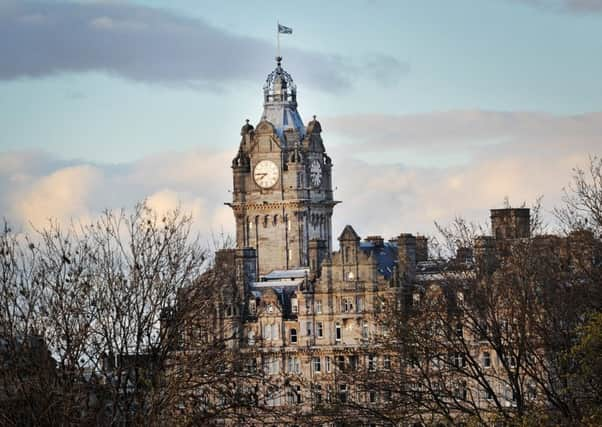Donald Anderson: Edinburgh must not be scared of change


‘Finally, there is Princes Street. In the minds of many the jumble of buildings along this street is now irremediable. But in our view the site is of such importance that an attempt should be made to solve the problem. The new design should avoid the monotonous uniformity of the original and the chaotic confusion of the modern frontage.”
These are not my words but are from the Report of the Lord Provost’s Advisory Committee on City Development, published way back in 1943. The report also talks about the issues in the city’s Royal Mile, which back then wasn’t a gleaming spectacle full of tourists as highlighted in a council report published just this week. In fact, the High Street was derelict.
Advertisement
Hide AdAdvertisement
Hide AdThe report states that “the houses have been gradually allowed to sink into decay. Many of them are now closed and windowless, many patched and broken, affording precarious shelter to their inhabitants. They attract the interest, and, owing to their condition, the amazement of the tourists who visit them”.
It’s an incredible report and was seminal in getting the city to take action to restore the fortunes of its centre, leading ultimately to, among other things, the 1960s Princes Street Masterplan. While the report shows remarkable vision and foresight, the eventual outcomes were mixed, as is demonstrated by even a cursory glance along Princes Street today.
There are those in Edinburgh who decry modern developments in the city. Indeed, the tourism industry has attracted claims from some that it is spoiling Edinburgh for its residents. But the growing pains of success are far easier to deal with than the dereliction and decay of economic failure described in the 1940s. Yet, hardly a day goes by without controversy over something new that’s decried as demeaning or damaging to what everyone agrees is our stunningly beautiful city.
Tourism is an amazingly vibrant sector of the economy. Remember all those tourists mean that Edinburgh has the highest proportion of restaurants of any city in the UK; we also have more facilities like theatres than any city of half a million could reasonably support and a lot more shops too. When we go on holiday, our flights and holidays are much cheaper than they would be were it not for the millions of trips coming the other way. Edinburgh residents get huge benefits from developments that strengthen our economy and the city.
Edinburgh is far from perfect, but it’s a triumph of urban planning and most modern developments are high quality and have transformed Edinburgh from the dereliction of the 1940s – and from the tired and dull provincial city of the 1980s – into a genuinely world-class place to live and work. But development isn’t easy. We all like remembering things as they were, and it’s just human nature to be concerned about change. Controversy’s not new in Edinburgh, and we need to remember that those who resist or even abuse change are perfectly entitled to their view. Of all cities, Edinburgh has always been a place of vigorous political debate.
We all now love the Balmoral Hotel (then the North British), but the plans for it were decried by our wonderful historical watchdog, The Cockburn Association, which, horrified at the way it completely dominated its surroundings fiercely opposed it, saying: “Any appreciation of its architecture is neutralised by the sense of disproportion which its height and breadth conveys.” Other critics described it as “course and obstructive” and spoke of the “aggressive bulk” and “bulbous clock tower”.
Indeed, there was no celebration of the opening of the “NB”, just a small advert in this very paper announcing the opening. The Caledonian Hotel, opened a year later, was also greeted in the most withering terms by the Cockburn Association. It was labelled “an eyesore which obtrudes itself on the eye of the observer to the detriment of its surroundings, and as such will stand as a witness to all time of the apathy of the generation which tolerated its erection”. Historically, the Caledonian must have offended conservation less as it is now Category ‘A’ listed – like Leith’s Banana Flats – whereas the Balmoral just gets a lowly ‘B’ listing.
The problem is there’s just no such thing as ‘love at first sight’ in architecture. As with the Balmoral and the Caley, time can make us love buildings we hate when they’re new. What we need to do is to raise the quality of debate about new buildings and lower the anger and rage. Too often the argument becomes polarised by those who ‘oppose development’ and those like myself who welcome it. There are no ‘goodies’ or ‘baddies’ in such debates and both sides do love Edinburgh with genuine passion. Rightly so. Despite the controversies about development in Edinburgh, residents are happier than ever with life in Edinburgh. Satisfaction with life in the city has risen to 96%, which is pretty much everyone.
Advertisement
Hide AdAdvertisement
Hide AdDevelopment has not spoiled Edinburgh. It has made it better and its people wealthier and happier, and that helps protect those buildings we love. What we do need is to focus on improving the debate about new proposals and making development better. In the original city of the Enlightenment, and the city that helped create the modern world through the contributions of an array of geniuses of the sciences and the arts, we must try and do better. The future of the city – this fantastic wonderful city and its people – deserves no less.
